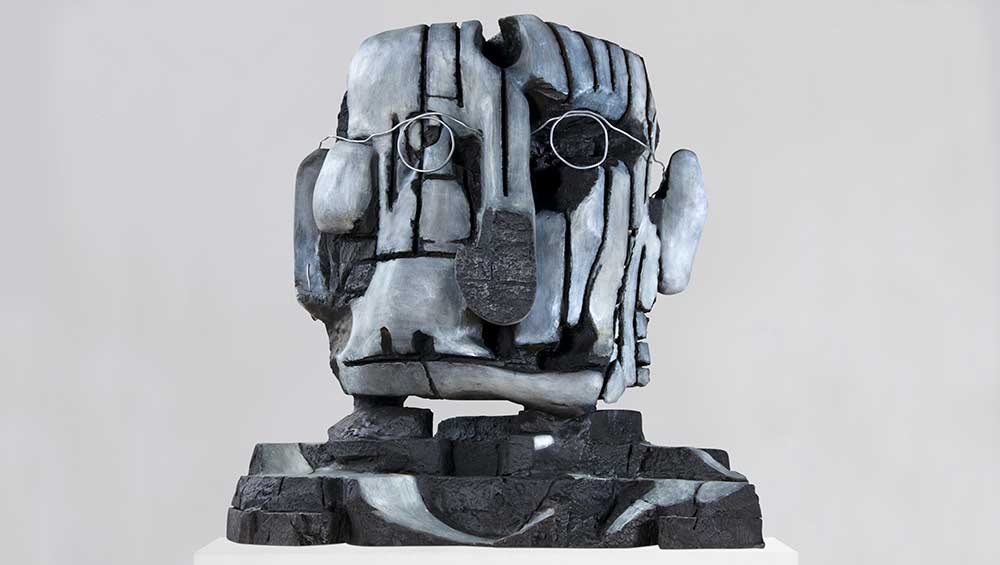
Nicole Eisenman, Econ Prof, 2019. Bronze, 78.7 x 58.4 x 78.7 cm. The Rachel and Jean-Pierre Lehman Collection. Image courtesy the artist and Hauser & Wirth.
Whitechapel Gallery, London
11 October 2023 – 14 January 2024
by JOE LLOYD
Nicole Eisenman (b1965) burst on to the art world with an unending barrage of smut and cruelty. Women hunt down men and truss them up above icy pits. Pagan Guggenheim (1994), a wall-bound assemblage of drawings, photographs and found objects, includes an alphabet made of nude bodies, a Leda willingly consorting with swans, and the tiers of the titular New York museum filled with cavorting bodies, like an obscene modernist update of Tintoretto’s Paradise (1588-94). Swimmers in the Lap Lane (1995) sees a pool descend into an orgy of touchings, tossings off, spoonings and other entanglements, to the discomfort of anyone who just wants to swim.
The French-born American artist, long a habitué of the Brooklyn scene, arrived with an irreverence that seemed particularly bracing when placed against the Old Master grace of her brushwork and the grandeur of her vision. Girl Scouts selling cookies were turned into scenes worthy of a Neapolitan altarpiece. The monumental Foos Ball Trilogy (1994), a triptych of tumbling nude bodies, joined the dots between comic books and the fleshy crowd scenes of Michelangelo and Joachim Wtewael. These, which occupy the first sections of the Whitechapel Gallery’s thrilling survey What Happened, remain exciting and troubling in equal measure. But what came after confirmed Eisenman as one of the most interesting painters working today.
.jpg)
Nicole Eisenman, Sloppy Bar Room Kiss, 2011. Oil on canvas, 99.1 × 121.9 cm. Collection of Cathy and Jonathan Miller. Image Courtesy of the artist and Vielmetter Los Angeles. Photo credit: Robert Wedemeyer.
In the 00s, Eisenman moved from obscene fantasies to fantastical frankness. She depicts the travails of the contemporary artist with unusual candour. In From Success to Obscurity (2004), she casts herself as a deflated relative to superhero The Thing, brows furrowed in anger and despair as she reads what might be a rejection letter from a gallery. Hung next to it, Commerce Feeds Creativity (2004) draws on the perverted art of New Objectivity to show a dribbling, bound artist being spoon-fed by a grim figure in a hat. There is an inheritance here from those Weimar artists who charted the hard-scrabble reality of their milieu, and from their own predecessors in the moral allegories of the Northern Renaissance.
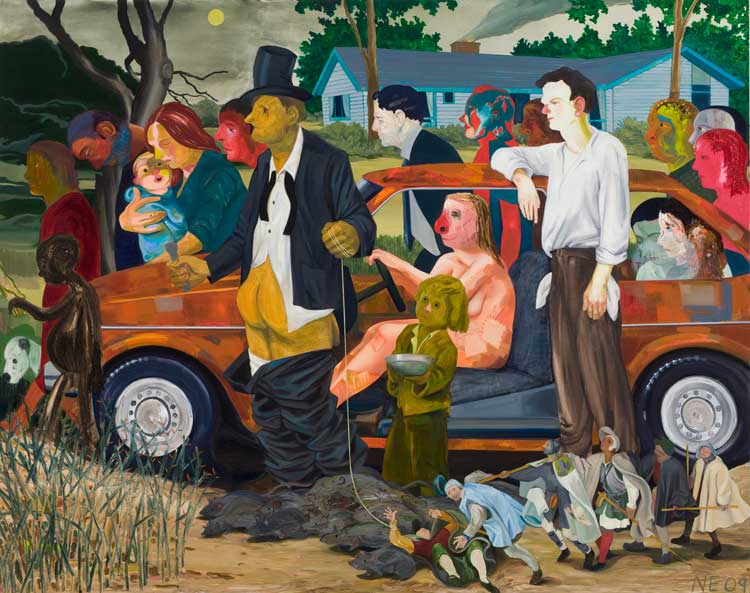
Nicole Eisenman. The Triumph of Poverty, 2009. Oil on canvas, 165.1 x 208.3 cm. From the Collection of Bobbi and Stephen Rosenthal, New York City. Image courtesy Leo Koenig Inc., New York.
The monumental The Triumph of Poverty (2009), painted during the Great Recession, borrows its name from Hans Holbein and a row of tumbling figures from Pieter Bruegel’s The Blind Leading the Blind (1568). Above them, in a scene that seems to be set in America’s midwest, we have a procession of the impoverished. There is a jaundiced boy holding a begging bowl, another child who seems to have started to lose form and definition, a mother clasping her child. Front and centre, holding the string that drags Bruegel’s rabble, is a suited avatar of capitalist wealth. He too is blind. His trousers have fallen down, revealing an arse in place of a crotch. The world is turned back to front.
Eisenman’s work is often at its finest during periods of American carnage, and the years since 2000 have given her plenty of material to work with. She describes the unease that attends turmoil over the eruptions themselves. Coping (2008) shows various people crossing what looks like either a Mitteleuropean village or a newly built approximation of one, wading up to their knees in a brown slurry. These figures are varied in character – there is a nude woman, an elegant feline with a parakeet-like bird on its shoulder, and what appears to be a bandaged mummy – and in the style in which Eisenman depicts them. One man has the pale visage of an Edvard Munch ghoul, another the yellowed hue and subdued dress of an Albrecht Dürer portrait, and a third the verisimilitude of a Christian Schad subject.
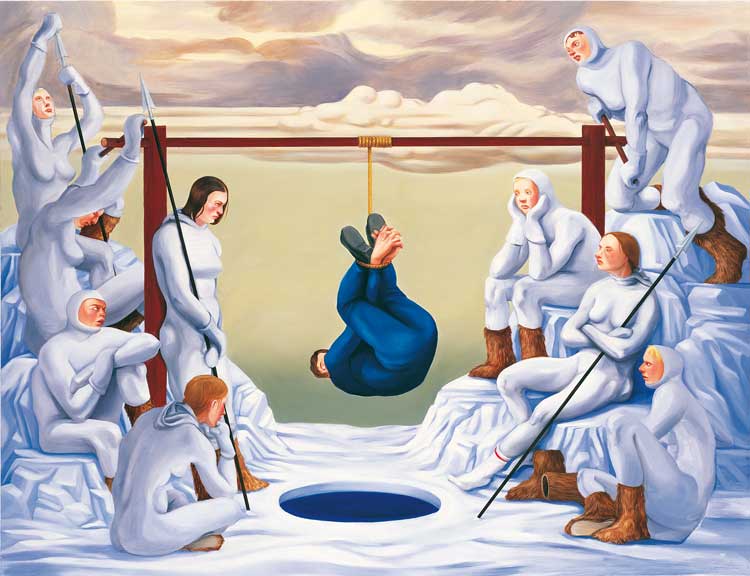
Nicole Eisenman, Fishing, 2000. Oil on panel, 121.9 x 142.2 cm. Collection Craig Robins, Miami. Image courtesy Carnegie Museum of Art. Photo: Bryan Conley.
This mixing and matching of modes within the same work could be exhausting, virtuosic peacocking for the sake of it. But Eisenman paints fluidly and conscientiously. Her decisions make sense. And there is a truthfulness to it. She reflects how we see individual people in different ways and how the images we have absorbed inform the way we view the world. In Seder (2010), based on a memory of a Passover feast presided over by her mother, Eisenman’s characters range from realistic to cartoon. One has a graphic novel flatness, another a Willem De Kooning melted face. In the foreground two distinctly Philip Guston-esque big pink hands break the matzah bread. Has the artist remembered an occasion that happened, or has she melded together the true and the false, the real and the imagined?
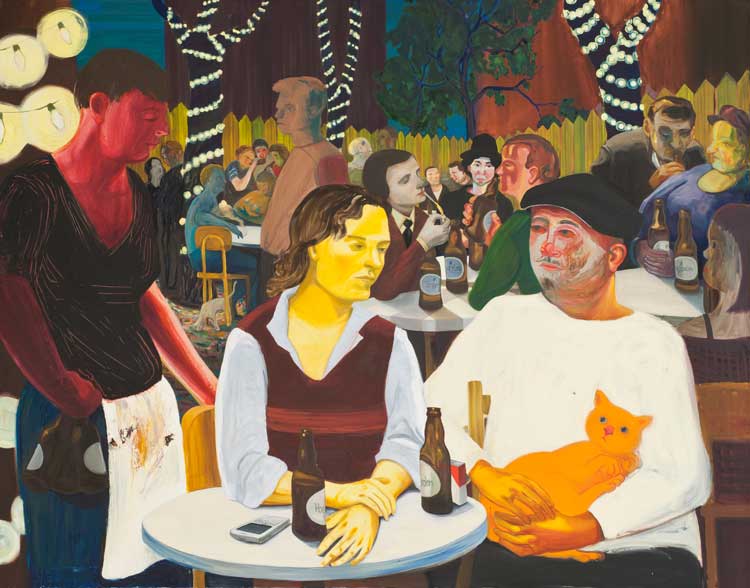
Nicole Eisenman, Beer Garden with Ulrike and Celeste, 2009. Oil on canvas, 165.1 × 208.3 cm. Hall Collection. Image courtesy Hall Art Foundation. Photo: Bryan Conley.
Eisenman’s ability to stitch together modes makes her crowd scenes a particular pleasure. Beer Garden with AK (2009), one of several drinking paintings Eisenman executed around the dying days of George W Bush’s presidency, features the artist herself and others conversing in a Brooklyn biergarten. Look at the decadence of our lives, it seems to say, idly chatting, bemoaning injustices and drinking beer while the world crumbles around us. Few artists have translated this feeling so well. A cluster of beer bottles takes us back to Pierre-Auguste Renoir’s Luncheon of the Boating Party (1880-81). But the jollity of Renoir’s floating restaurant scene has been supplanted by a vague feeling of disenchantment. The central figure looks inwardly while clasping a pre-Android phone.
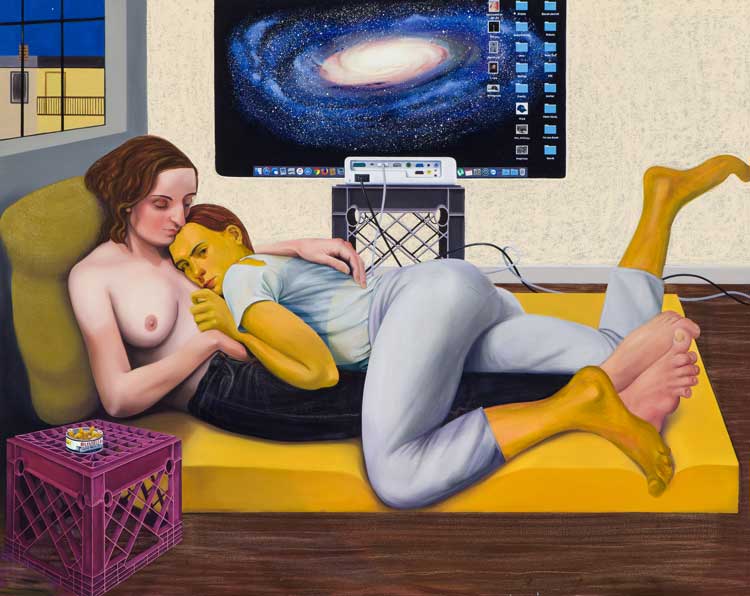
Nicole Eisenmann, Morning Studio, 2016. Oil on canvas, 167.6 x 210.8 cm. The Hort Family Collection. Image courtesy the artist and Anton Kern Gallery, New York.
In the last decade, Eisenman has turned to sculpture, satirised the Trump era and made digital technology a motif. Selfie (2014) has a Guston cyclops snap his own single eye. A man receives a break-up by text, while another person logs on to continue a long-distance relationship. These works capture the way phones and computers have changed how we interact with ourselves and others, a new way of channelling human behaviour. Morning Studio (2016) has two women lolling on a mattress in an embrace. The dark sky behind suggests that this is a morning of the early kind. Behind this scene of passion is a projection of a MacBook desktop showing the Andromeda galaxy, every star meticulously rendered. Screens have become the backdrop to even the most intimate moments, uselessly glowing on the wall. The same could not be said of Eisenman’s vital, energetic paintings. There’s life in the old brush yet.